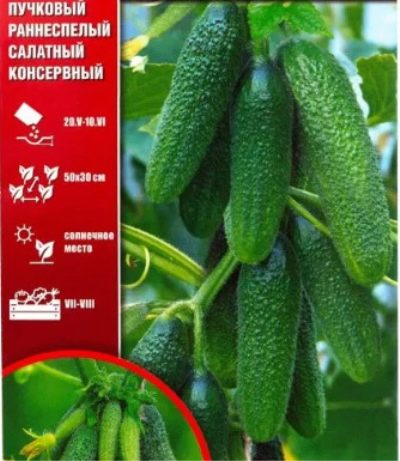
- Authors: Kachainik V.G., Gulkin M.N., Golovko G.V., Shishkin N.V.
- Year of approval: 2018
- Growth type: indeterminate
- Branching: the average
- Fruit weight, g: 60-80
- Fruit length, cm: 7-9
- Fruit color: green
- Ripening terms: early
- Fruit shape: cylindrical
- Fruit taste: good
The green garland is a salad variety of cucumbers bred by Russian breeders. It has a good taste and a rich harvest, as well as unpretentious care, but the basic rules of agricultural technology must be followed.
Description of the variety
The presented variety belongs to parthenocarpic varieties, that is, the culture is capable of producing fruits without pollination. The variety is allowed to be kept both in open ground and under a temporary film cover. Usually, the crop is harvested for 2-3 days, and the fruits are stored in a room where the temperature is maximum +5 degrees and humidity is 85%.
Characteristics of the appearance of plants and zelents
The bush of the presented variety is of an indeterminate type, has medium branching and medium-sized green leaves. The type of flowering is predominantly female, two female flowers are formed in one node, 4-6 cucumbers are formed in one bunch.
Fruits are green, small tuberous, develop in the form of a cylinder, short, 7-9 cm long, weighing 60-80 g.
Purpose and taste of fruits
This variety has a pleasant, sweet, cucumber taste and good aroma, the pulp is firm and juicy. It can be consumed fresh, especially the taste of zelents will be revealed in a vegetable vitamin salad. Due to its compact size, it is also well suited for canning.
Maturation
This variety belongs to a crop with an early ripening period, the fruits appear already 45 days after the first seedlings are hatched.
Yield
It is a high-yielding variety capable of producing an average of 14 kg of vegetables per square meter.
Landing scheme
Seeds are sown in April-May, and the sprouts will be ready for transplanting in open ground at the age of 20-30 days. The same terms are set for growing vegetables under a film, in a greenhouse or greenhouse.
The culture loves light, fertile, well-fertilized soil. When landing in open ground, choose a sunny area, well-lit and sheltered from the wind. When cultivating in a greenhouse, follow the planting scheme - 2-3 plants per 1 m2 or 40 x 50 cm.
Growing and care
When caring for a plant, observe the following rules.
Water the hybrid every 3-4 days. If a very dry period has come, then moisturize the ridge every day. Use warm, settled water for this, pour it under the root. If drops get on the green mass, the risk of developing diseases increases.
Tie the main crop stem to the vertical support with a strong rope. If the bush grows too intensively, then the top can be fixed from below.
Feed the plant regularly. Fertilize the soil with minerals once every two weeks. Cucumbers respond well to feeding with manure, chicken droppings, compost, and potassium-phosphorus mixtures.
After watering, loosen the soil. Avoid crusting, which will prevent moisture and oxygen from reaching the roots.

In order to collect strong, tasty and beautiful cucumbers on your site, you need to make top dressing.Lack of nutrients can negatively affect the appearance of the plant and significantly reduce the yield. Fertilize cucumbers with organic fertilizers in combination with mineral fertilizers. With the right balance of these components and adherence to the fertilizing schedule, the cucumber yield will be maximum.
Disease and pest resistance
The presented variety is rarely affected by diseases and pests. So, it has a high immunity to powdery mildew, however, if the rules of agricultural technology are not followed, it can become infected with various rot or mosaics.
The means "Trichocin" or "Fundazol" will help to prevent root rot, and the preparations "Rovral" and "Sumileks" can protect against gray rot. For ordinary mosaics, it is recommended to use "Aktara", "Aktellik", Burgundy liquid is also suitable.

Despite their popularity, cucumbers are often attacked by diseases and pests. From them, cucumber plantings often die before the start of fruiting. In order to prevent this from happening, it is necessary to try to prevent ailments or get rid of them at the very beginning, having studied in detail their causes of occurrence, signs and methods of treatment.
Review overview
The presented variety receives different reviews from gardeners. Among the advantages, the excellent germination of the hybrid, good taste are noted, however, summer residents who first started growing the variety were unhappy with the harvest - its volume clearly did not correspond to the figures indicated by the seed manufacturer. And also the disadvantages of gardeners include the absence of side lashes and the weak development of the root system.





























































































